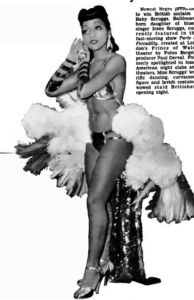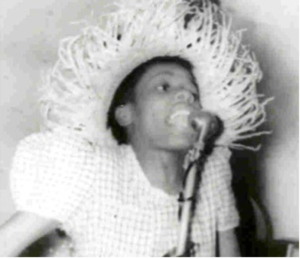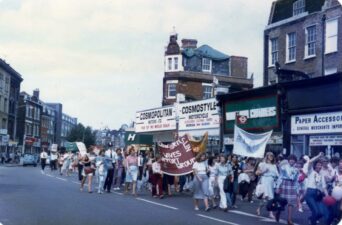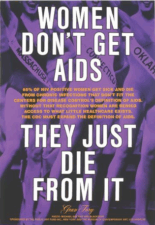In Blues Legacies and Black Feminism (1998), philosopher Angela Davis considers the “ideological implications of the blues,” asking “What can we learn from blueswomen like Gertrude ‘Ma’ Rainey, Bessie Smith, and Billie Holiday…?” Though the music of artists like Bessie Smith reemerged in the 1960s and 1970s, lesser-known blues artists like Irene Scruggs faded into obscurity as American popular music and culture grew more conservative after World War II and during the Cold War.
Irene Scruggs was born in 1901 in the unincorporated area of Lamont in the Mississippi Delta. She grew up in Missouri and started performing Piedmont blues in the Greater St. Louis Area, known for legends like Tina Turner and W.C. Handy. Though sources on Scruggs are scarce, blues scholars have attempted to include her in anthologies and articles.
The Piedmont style is known for its similarity to ragtime and country music. Also called “eastern blues,” the genre was named for the Piedmont area in Virginia, as well as nearby regions in South Carolina and Georgia. Journalist Richard Harrington writes that in comparison to Delta blues, “its repertoire is less rigid.”
Most of Scruggs’ music is also “dirty blues,” known for lyrics that challenged the social norms of the early twentieth century. Davis explains that although blueswomen can be portrayed as victims, they rarely wrote songs that showed a passive acceptance of violence. They communicated political critique through entertainment, as they sang about issues like poverty, natural disasters, and the criminal justice system. In “Itching Heel” (1930), Scruggs sang, “He don’t do nothin’ but play on his old guitar, while I’m bustin’ suds out in the white folks’ yard.”
Articles on Scruggs tend to cite her more popular songs “Good Grinding” and “Must Get Mine in Front,” recorded with Little Brother Montgomery in 1930, as evidence for her willingness to sing about explicit themes. Like the pre-Hays Code films of the early 1930s, songs like Bessie Smith’s “Need a Little Sugar in My Bowl” (1931) are significant because they depict or allude to sex and drug use, among other subjects considered taboo at the time.
Like “Good Grinding,” other songs in Irene Scruggs’ small catalog defied the societal conventions of the time. In “My Back to the Wall” and “Borrowed Love,” she sings honestly about extramarital affairs, claiming she would “get the first train going anywhere” to see her lover. Her 1930 song “You’ve Got What I Want” can be compared to dirty blues classics like Ma Rainey’s “See See Rider” and Robert Johnson’s “Travelin’ Riverside Blues,” made infamous by the lyrics of Led Zeppelin’s “The Lemon Song” in 1969.
Though, as Davis rightly explains, “the protagonists in women’s blues are seldom wives and almost never mothers,” many of the women did have children in their private lives. Irene Scruggs’ daughter “Baby” Scruggs became a shake dancer in 1950s London and Paris. Shake dancers were burlesque performers named after a specific mid-century dance.

“Baltimore Dancer Clicks in London,” Jet, Vol. 2, No. 2 (May 1952)
The most well-known photograph of Baby Scruggs shows her at the Prince of Wales Theatre in 1952, and a Jet magazine article from the same year explained how she went from being little-known in the U.S. to dancing for a producer for the Folies Bergère. In 1953, Jet reported that Scruggs was so famous that she insured certain parts of her body with Lloyd’s of London.
In the 1940s, Irene Scruggs and her daughter joined many black artists and thinkers who had become expatriates during the twentieth century, like dancer Josephine Baker and writer James Baldwin. Scruggs continued singing in Europe, and some of the more well-known performances from her later years are in a set of mid-century BBC recordings. After living in Paris and London, she died in the historic city of Trier, West Germany in 1981.
With exceptions like the literary movement of The Beats, American popular culture grew more moderate or conformist with the Cold War and presidency of Dwight Eisenhower. In his history of the iconic Chicago label Chess Records, Rich Cohen describes how the blues as a whole was transformed after World War II: “In an essay in Cashbox, [record executives] Ahmet Ertegun and Jerry Wexler predicted the trend, saying the Blues would change to meet the taste of…white kids seeking authentic experience.”
While more obscure artists like Irene Scruggs never recovered their fame after losing recognition in the U.S., the blues as a whole did resurface in popular culture through the British Invasion, as well as through the music of American artists like Bob Dylan. In 1968, Nina Simone covered Bessie Smith’s “Need a Little Sugar in My Bowl.” Robbie Robertson and Rick Danko of The Band would record a new song addressed to Smith in 1975 for The Basement Tapes.
Though bands like the Rolling Stones and The Beatles reintroduced Chess legends like Muddy Waters to popular music in the 1960s, new acts sometimes neglected to cite their sources. For example, Chess writer Willie Dixon won a 1985 court case against Led Zeppelin for copying Muddy Waters’ 1962 song “You Need Love.”
Irene Scruggs’ choice to leave the U.S. for popularity and fame in Europe was far from exceptional in twentieth-century American culture.
Along with London and West Germany, Scruggs spent a significant amount of time in France. In a recent book on St. Louis music, Bruce R. Olson explains that in the 1940s, “Scruggs lived in Paris, enjoying the popularity American black performers were accorded there after the war.”
Journalist Samuel G. Freedman writes that by leaving the country, a similar group of artists, the “jazz expatriates,” chose to act “out of a sense of imperative, of necessity – the necessity to work, the necessity to be accepted as an artist, the necessity to be treated as a human being.” While Scruggs traveled Europe in the early 1960s, Chess recording artist Buddy Guy felt the need to keep his day job driving a tow truck.
Sources/Further Reading (selected)
Tom Ball, The Nasty Blues (1995)
“Baltimore Dancer Clicks in London,” Jet, Vol. 2, No. 2 (May 1952)
Eugene Chadbourne, “Irene Scruggs,” AllMusic.com
Ann Charters, The Portable Beat Reader (1992)
Lizabeth Cohen, A Consumer’s Republic: The Politics of Mass Consumption (2003)
Rich Cohen, The Record Men: The Chess Brothers and the Birth of Rock &Roll (2004)
Angela Davis, Blues Legacies and Black Feminism (1998)
Bob Eagle and Eric S. LeBlanc, Blues: A Regional Experience (2013)
Samuel G. Freedman, “The Blues of Expatriate Paris: Recalling America’s Jazz Exiles,” New York Times (1986)
Richard Harrington, “The Piedmont Style,” The Washington Post (2003)
“Irene Scruggs,” Wbssmedia.com
Greil Marcus, The Basement Tapes Liner Notes
Bruce R. Olson, That St. Louis Thing, Vol. 1: An American Story of Roots, Rhythm and Race (2016)
Robert E. Pierre, “Buddy Guy’s Dues Are Paid in Full,” The Washington Post (2003)
Tony Russell, The Blues (1997)
Michael Taft, Talkin’ to Myself: Blues Lyrics, 1921-1942 (2005)
“Shake Dancer Insures Bust,” Jet, Vol. 3, No. 25 (April 1953)
“Why Girls Become Shake Dancers,” Jet, Vol. 4, No. 25 (October 1953)


